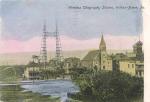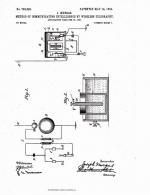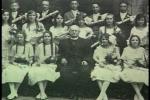![header=[Marker Text] body=[Pioneer in development of overland wireless telegraphy. In 1898 he began his experiments on these grounds. His first public transmission of sound was made here on Nov. 23, 1905. Pastor, artist, biologist, and a supporter of Slovak aspirations, he died in 1929.] sign](http://explorepahistory.com/kora/files/1/10/1-A-3A1-139-ExplorePAHistory-a0m4r5-a_450.jpg)
Mouse over for marker text
Name:
Rev. Joseph Murgas
Region:
Poconos / Endless Mountains
County:
Luzerne
Marker Location:
At Sacred Heart Church, 601 N. Main St., Wilkes-Barre
Dedication Date:
November 25, 1990
Behind the Marker
"What hath God wrought?"
These were the first words Samuel Morse transmitted over the first U.S. telegraph landline in 1844. They had been selected by Annie Ellsworth, the daughter of the first Commissioner of the U.S Patent Office. Her choice of words could not have been more appropriate. Through his transmission of simple electrical signals, Morse had helped shrink the size of the world, inaugurating a new age of instant communications across vast distances. He had also unleashed an international competition for better, faster and cheaper methods of electrical communication.
In the decades that followed, inventors around the world raced to invent, patent and market new communication technologies, and cutthroat business interests vied for commercial supremacy. After Alexander Graham Bell unveiled his new "telephone" at the Philadelphia Centennial Exposition in 1876, a new wave of innovation and cutthroat competition quickly followed. By the dawn of the 20th century, a new generation of inventors and engineers were seeking to shed the constraints of wire-based cables.
The early wireless telegraph systems used a "spark," an actual electric current that jumped a gap in a circuit, in order to generate a signal. They were loud, cumbersome, power-hungry, and often unreliable. Significant improvement came from the most unlikely of sources: the work shed of a Catholic priest in a Slovak church in Wilkes-Barre, Pa. In 1904, Joseph Murgas of Wilkes-Barre patented a "rotary spark" method for generating "musical tones," which promised to increase the volume of information that could be sent by wireless telegraphy.
Born on February 17, 1864, in the village of Tajov in the Lower Tatras region, Jozef Murgas entered the priesthood in Slovakia as a young man, attended art school in Munich, and then studied at the Electrical College of Vienna. In 1896, Murgas joined the great wave of Eastern Europeans who were immigrating to the United States. That September, Murgas became pastor of the Sacred Heart Slovak Church in Wilkes-Barre, a gritty boom town in the heart of Pennsylvania's anthracite-coal region. There he ministered to his immigrant congregation and set up a workshop in the basement of the church rectory, where he worked obsessively, early mornings and late nights, constructing apparatus for his experiments in wireless telegraphy.
The dream of wireless telegraphy had become a reality in the 1890s when Nikola Tesla in the U.S. and Italian inventor Guglielmo Marconi found ways to use radio waves to transmit telegraph messages without wires. Marconi's "spark" radio, however, could at first only generate a simple, uniform signal.
Working in his basement workshop, Murgas in the early 1900s developed a "Musical Tone System" that by introducing a variety of tones through a high-speed alternator to the "spark" enabled faster recognition of Morse code signals. If successful, Murgas' musical-tone system, and a similar system developed independently by William Duddell in England, would be a significant improvement over single-tone systems.
In 1904, Murgas patented his musical-tone system and began to construct the towers needed for its demonstration. By 1905, he entered into a partnership with a group of Philadelphia-based investors, led by Joseph F. Stokes and Ferdinand Muckley, who formed the Universal Aether Telegraph Company to develop and market Murgas' system. Universal Aether then financed the construction of two 150-foot high antenna towers of pine and iron on Bowman Hill behind the Sacred Heart Church in Wilkes-Barre. Between these, Murgas strung antennae made of ten insulated copper cables, each hung from insulators of polished rubber, which attached to a 150,000-volt insulator. The partners then constructed similar towers nineteen miles away in Scranton, Pa.
needed for its demonstration. By 1905, he entered into a partnership with a group of Philadelphia-based investors, led by Joseph F. Stokes and Ferdinand Muckley, who formed the Universal Aether Telegraph Company to develop and market Murgas' system. Universal Aether then financed the construction of two 150-foot high antenna towers of pine and iron on Bowman Hill behind the Sacred Heart Church in Wilkes-Barre. Between these, Murgas strung antennae made of ten insulated copper cables, each hung from insulators of polished rubber, which attached to a 150,000-volt insulator. The partners then constructed similar towers nineteen miles away in Scranton, Pa.
During a long-range test between the two sites in 1905, Murgas was able to transmit telegraph signals at a rate of 50 words per minute at a time when Marconi's system could only generate fifteen words per minute. Murgas' success soon attracted the attention of the U.S. Navy, which hired him as a consultant for its own efforts to improve wireless telegraphy.
The venture, however, soon began to unravel when three of the main investors in Universal Aether died, a storm collapsed his towers at Scranton, and other multiple-tone systems successfully entered the marketplace. Out of money, Murgas ceased promoting his system, and sometime around 1912 stopped all experimentation. Innovations in wireless communication moved swiftly in the early 1900s, and Murgas was soon left behind as new technologies emerged. The "spark" technology that Murgas' work had helped advance were quickly replaced by systems that generated a continuous radio wave, and Morse code signals were replaced by radio telephony (voice transmission).
After abandoning his experiments in wireless telegraphy, Murgas concentrated on his parish work and devoted his free time to other interests. A skilled painter, poet, avid fisherman, and naturalist, he registered a patent an early spinning reel and amassed a collection of 9,000 butterflies before his death on May 11, 1929.
Murgas was also active in the struggle Slovak independence from Austria-Hungary. A signatory of the 1918 Pittsburgh Agreement, which called for the creation of an independent state of autonomous Czech and Slovak regions, Murgas headed fundraising efforts that raised more than a million dollars for that cause. In 1939, Slovakia named its sole radio station after Murgas and issued a commemorative stamp in his honor. When President Franklin Roosevelt christened a ship in his honor in 1944, American newspapers remembered Father Murgas as a staunch activist for Slovakian independence rather than as a radio pioneer.
Pittsburgh Agreement, which called for the creation of an independent state of autonomous Czech and Slovak regions, Murgas headed fundraising efforts that raised more than a million dollars for that cause. In 1939, Slovakia named its sole radio station after Murgas and issued a commemorative stamp in his honor. When President Franklin Roosevelt christened a ship in his honor in 1944, American newspapers remembered Father Murgas as a staunch activist for Slovakian independence rather than as a radio pioneer.
Murgas, however, would not have cared. Reflecting on his work in wireless telegraphy, he would later write, "I do not want this patent to be lost to the human race .... I have no interest in the business side of my scientific research. Whatever else happens, let it be the will of God."
"What hath God wrought?"
These were the first words Samuel Morse transmitted over the first U.S. telegraph landline in 1844. They had been selected by Annie Ellsworth, the daughter of the first Commissioner of the U.S Patent Office. Her choice of words could not have been more appropriate. Through his transmission of simple electrical signals, Morse had helped shrink the size of the world, inaugurating a new age of instant communications across vast distances. He had also unleashed an international competition for better, faster and cheaper methods of electrical communication.
In the decades that followed, inventors around the world raced to invent, patent and market new communication technologies, and cutthroat business interests vied for commercial supremacy. After Alexander Graham Bell unveiled his new "telephone" at the Philadelphia Centennial Exposition in 1876, a new wave of innovation and cutthroat competition quickly followed. By the dawn of the 20th century, a new generation of inventors and engineers were seeking to shed the constraints of wire-based cables.
The early wireless telegraph systems used a "spark," an actual electric current that jumped a gap in a circuit, in order to generate a signal. They were loud, cumbersome, power-hungry, and often unreliable. Significant improvement came from the most unlikely of sources: the work shed of a Catholic priest in a Slovak church in Wilkes-Barre, Pa. In 1904, Joseph Murgas of Wilkes-Barre patented a "rotary spark" method for generating "musical tones," which promised to increase the volume of information that could be sent by wireless telegraphy.
Born on February 17, 1864, in the village of Tajov in the Lower Tatras region, Jozef Murgas entered the priesthood in Slovakia as a young man, attended art school in Munich, and then studied at the Electrical College of Vienna. In 1896, Murgas joined the great wave of Eastern Europeans who were immigrating to the United States. That September, Murgas became pastor of the Sacred Heart Slovak Church in Wilkes-Barre, a gritty boom town in the heart of Pennsylvania's anthracite-coal region. There he ministered to his immigrant congregation and set up a workshop in the basement of the church rectory, where he worked obsessively, early mornings and late nights, constructing apparatus for his experiments in wireless telegraphy.
The dream of wireless telegraphy had become a reality in the 1890s when Nikola Tesla in the U.S. and Italian inventor Guglielmo Marconi found ways to use radio waves to transmit telegraph messages without wires. Marconi's "spark" radio, however, could at first only generate a simple, uniform signal.
Working in his basement workshop, Murgas in the early 1900s developed a "Musical Tone System" that by introducing a variety of tones through a high-speed alternator to the "spark" enabled faster recognition of Morse code signals. If successful, Murgas' musical-tone system, and a similar system developed independently by William Duddell in England, would be a significant improvement over single-tone systems.
In 1904, Murgas patented his musical-tone system and began to construct the towers
During a long-range test between the two sites in 1905, Murgas was able to transmit telegraph signals at a rate of 50 words per minute at a time when Marconi's system could only generate fifteen words per minute. Murgas' success soon attracted the attention of the U.S. Navy, which hired him as a consultant for its own efforts to improve wireless telegraphy.
The venture, however, soon began to unravel when three of the main investors in Universal Aether died, a storm collapsed his towers at Scranton, and other multiple-tone systems successfully entered the marketplace. Out of money, Murgas ceased promoting his system, and sometime around 1912 stopped all experimentation. Innovations in wireless communication moved swiftly in the early 1900s, and Murgas was soon left behind as new technologies emerged. The "spark" technology that Murgas' work had helped advance were quickly replaced by systems that generated a continuous radio wave, and Morse code signals were replaced by radio telephony (voice transmission).
After abandoning his experiments in wireless telegraphy, Murgas concentrated on his parish work and devoted his free time to other interests. A skilled painter, poet, avid fisherman, and naturalist, he registered a patent an early spinning reel and amassed a collection of 9,000 butterflies before his death on May 11, 1929.
Murgas was also active in the struggle Slovak independence from Austria-Hungary. A signatory of the 1918
Murgas, however, would not have cared. Reflecting on his work in wireless telegraphy, he would later write, "I do not want this patent to be lost to the human race .... I have no interest in the business side of my scientific research. Whatever else happens, let it be the will of God."











